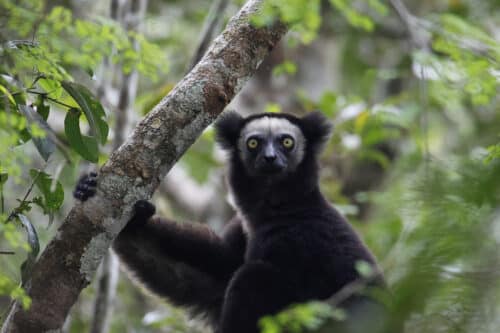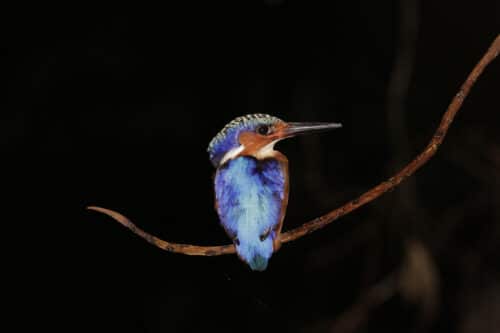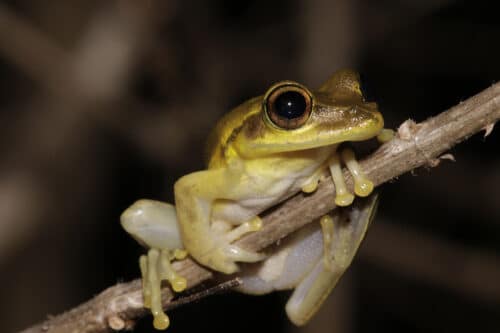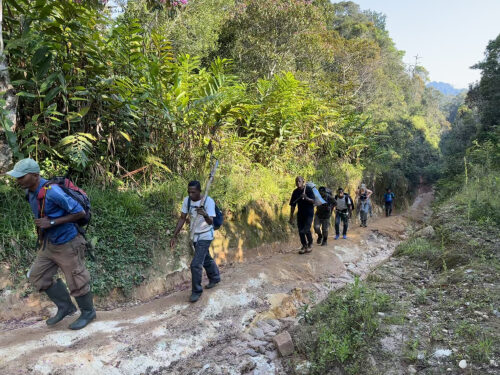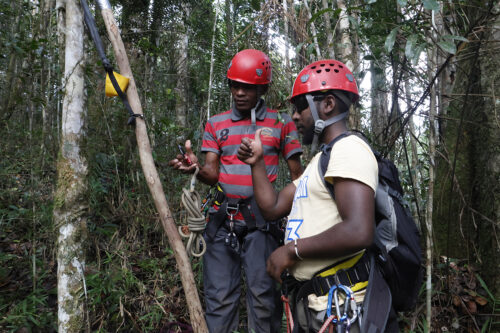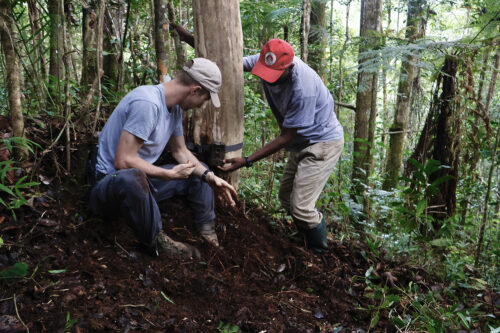You just returned from Anjanaharibe Sud Special Reserve where you were working on a new camera trapping project. Tell us about it!
Absolutely! the Anjanaharibe Sud Special Reserve (ASSR) protected area is an incredible forest!
I was excited to be able to lead another project here as its importance has only grown in the wake of continued habitat degradation in the SAVA region. Since the last survey that ended in spring of 2019, there has been more mining, logging, people, access, and more burning in the area for rice and other crops.
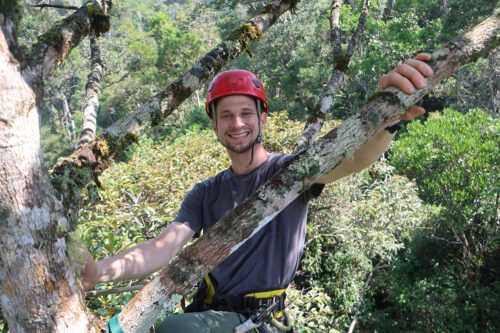
The basis of this research project came from many conversations about what knowledge gaps are missing in the protected area.
Many of our prior surveys had focused these camera trap stations on terrestrial wildlife. To build on that focus, we sought to re-sample the carnivore community (allowing for a pre-covid / present comparison), and sample the canopy communities!
So, we have trimmed up the old transects that we used in 2018, and established a few new ones. In total, we established 74 camera traps across 37 sampling stations, each of which included two camera traps within just a few meters of each other, one terrestrial and one in the canopy. The canopy camera traps are targeted towards silky sifakas by selecting their favorite trees. These trees are also favorites for many other lemurs. We placed the terrestrial camera traps on transects and trails where they were placed before and where we know wildlife will pass in front of them.
With these 74 camera traps, we will document the critically endangered Silky Sifaka occupancies in the forest but should also be able to sample nearly all of the lemur taxa within the forest.
What lemurs do you expect to find in ASSR?
One of the primary goals is to gain a better understanding of the silky sifakas.
They have an incredibly small population which is estimated to be somewhere between 200 and 2,000 individuals. (Download a PDF of the primates in peril document on Silky sifaka).
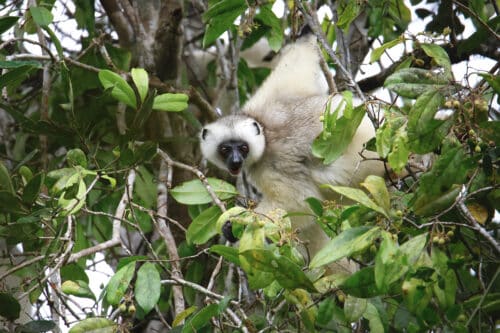
In total, eleven lemur species are known to live in ASSR.
This includes: ASSR Sportive Lemur (Lepilemur seali), Aye-aye (Daubentonia madagascariensis), Eastern woolly lemur (Avahi laniger), Greater dwarf lemur (Cheirogaleus major), Hairy-eared dwarf lemur (Allocebus trichotis), Indri (Indri indri), Mittermeier’s mouse lemur (Microcebus mittermeieri), Northern grey bamboo lemur (Hapalemur occidentalis), Red-bellied lemur (Eulemur rubriventer), Silky sifaka (Propithecus candidus), and White-fronted brown lemur (Eulemur albifrons).
We are very curious to see if there is a fork-marked lemur species, such as Phaner furcifer, in the reserve.
ASSR is very close to the northernmost boundary of this species’ known range. It would be great if we can confirm with camera traps that it’s here, or be confident enough to deny it’s there. Unlike the phaner species in the dry forests that is very loud, the one that lives nearby in Masoala is not loud. So, it’s harder to find.
We really hope to spot a lot of aye-ayes! Our previous terrestrial camera trapping effort in ASSR got a few pictures of Aye Aye, but I expect that these canopy based camera traps will see a lot more.
Are there any other animals you hope to find in ASSR through the camera traps?
Carnivores
In 2020 we published a paper in Endangered Species Research about the carnivore community of the protected area, so I am very much looking forward to re-examining that threatened taxa in the reserve.
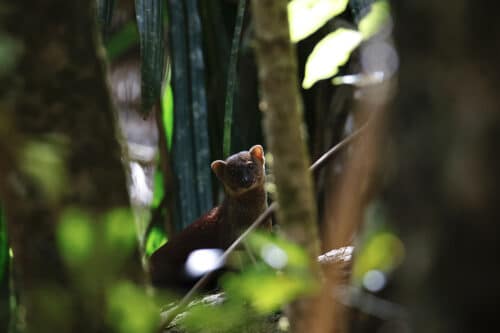
I’m particularly excited to see if we can spot the Eastern Falanouc (Eupleres goudotii) because it is rarely photographed. Other carnivores that we know are here include: the fossa, northern ring-tailed vontsira, the broad striped vontsira, and the fossana.
There is a publication of ours coming out soon in Biotropica, which surveyed carnivores in the nearby COMATSA protected area, which connects Marojejy National Park, Anjanaharibe Sud Special Reserve, and Tsaratanana Strict Nature Reserve. I am excited to pair this new canopy and terrestrial ASSR survey with this soon to publish COMATSA manuscript.
Birds
I am even more thrilled to see what wildlife the canopy cameras can capture. There is a huge set of bird data that I need to type up from past similar surveys. It will be awesome to compare that data to the bird data that the canopy cameras capture on this current survey.
What excites you about this project?
It’s the first time this kind of canopy project has happened in this forest, so we don’t really know what we’ll see.
Camera traps are magical in the sense that they don’t make sound, they don’t smell, and they never sleep. They are the perfect observer! They give us a peek into these forest communities that we cannot get any other way.

It’s exciting how this project builds on past research.
Modeling silky sifaka populations has been really difficult in the past, and it’s taken years and years of sampling. Dr. Erik Patel and his teams have been following silky sifakas for over a decade and they have a paper coming out soon on silky home range. This project not only builds on these soon to be published results but also builds on the suite of manuscripts that have already been published on this critically endangered species.
With camera traps in the trees, we are able to get spatial distribution data that we could never get otherwise!
By deploying canopy camera traps, we can not only observe these primates in ways that weren’t possible before but we can also calculate their spatial distributions which might offer insights vital for conservation efforts. There is also a new analysis for me in this, because we brought a drone out and were able to image half of the sites (before the drone gimbal cable broke). I’m planning on getting a satellite imagery pack that will allow us to compare each site.
We’ll have new analyses based on aerial imagery and remote sensing. This is a BIG DEAL for me!
Nothing in Madagascar is ever a solo effort. Who are your partners for this work?
This is truly a team effort.
First and foremost, the vast majority of the project was made possible by the Lemur Conservation Foundation. The LCF is the main funder, and has provided both logistical and financial support. I’m grateful to Dr. Erik Patel and Louis ‘Joxe’ Jaofeno of LCF for their tremendous support.
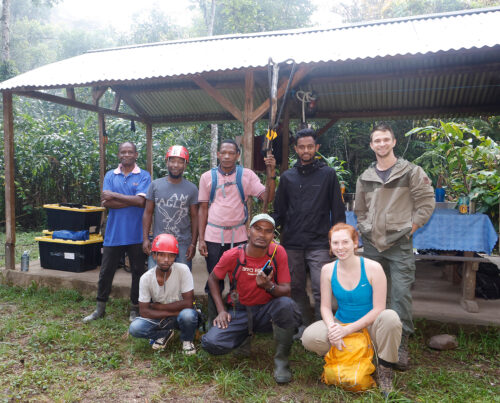
And, nobody could do this work without serious help from Malagasy guides, cooks, and porters. Those that we were able to work with were really amazing.
We are also collaborating with Dr. Tim Eppley (Chief Conservation Officer of Wildlife Madagascar), Dr. Zach Farris (Associate Professor at Appalachian State University and Co-founder of Mad Dog Initiative), and Dr. Luke Dollar (Professor / Chair of the Department of Environment & Sustainability at Catawba College). Our local partners include Madagascar National Parks, DREDD (Ministry of the Environment), and the University of Antananarivo.
Final words?
This project was a blast. It was a sprint to get all of the camera traps up and running! More than that, I’m so excited to see the results and what it means for ASSR, the silky sifakas, other lemurs, and carnivores that live there.
I also feel strongly that this project provides a great model for collaboration in conservation in Madagascar. We need more collaborative conservation like this across Madagascar!

